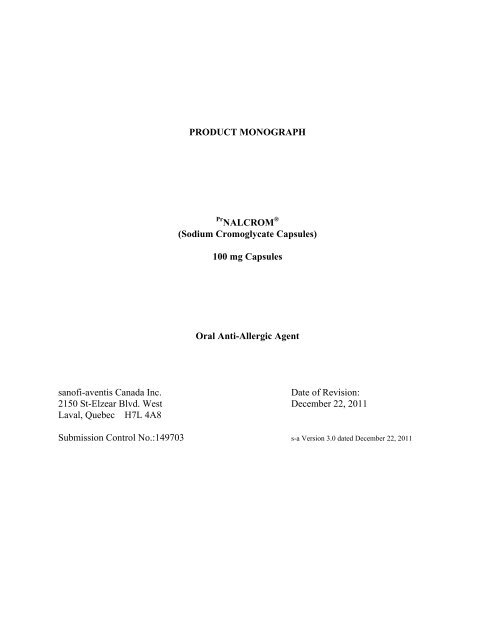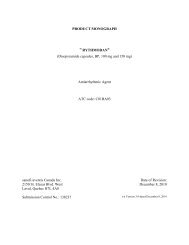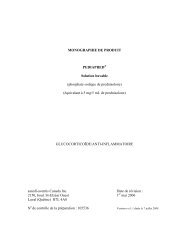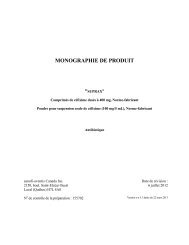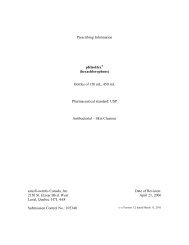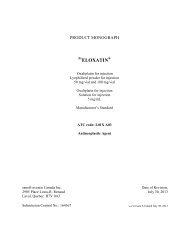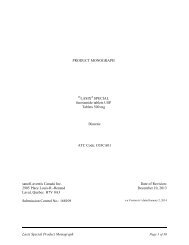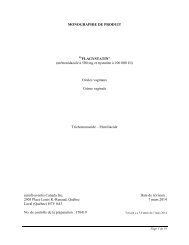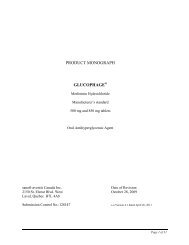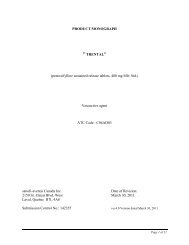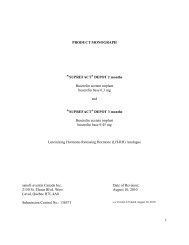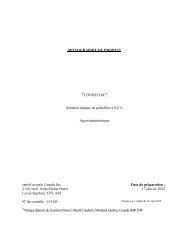Nalcrom (sodium cromoglycate) - Sanofi Canada
Nalcrom (sodium cromoglycate) - Sanofi Canada
Nalcrom (sodium cromoglycate) - Sanofi Canada
You also want an ePaper? Increase the reach of your titles
YUMPU automatically turns print PDFs into web optimized ePapers that Google loves.
PRODUCT MONOGRAPHPr NALCROM ®(Sodium Cromoglycate Capsules)100 mg CapsulesOral Anti-Allergic Agentsanofi-aventis <strong>Canada</strong> Inc.Date of Revision:2150 St-Elzear Blvd. West December 22, 2011Laval, Quebec H7L 4A8Submission Control No.:149703 s-a Version 3.0 dated December 22, 2011
TABLE OF CONTENTSSUMMARY PRODUCT INFORMATION.................................................................................3THERAPEUTIC CLASSIFICATION.................................................................................3ACTIONS ............................................................................................................................3INDICATIONS....................................................................................................................3CONTRAINDICATIONS ...................................................................................................4WARNINGS ........................................................................................................................4PRECAUTIONS ..................................................................................................................4ADVERSE REACTIONS....................................................................................................5DOSAGE AND ADMINISTRATION ................................................................................5SYMPTOMS AND TREATMENT OF OVERDOSAGE...................................................6AVAILABILITY .................................................................................................................7STRUCTURAL FORMULA AND CHEMISTRY .............................................................8PHARMACOLOGY............................................................................................................8ABSORPTION, DISTRIBUTION AND EXCRETION ...................................................10TOXICOLOGY .................................................................................................................11TERATOGENICITY.........................................................................................................14CARCINOGENICITY.......................................................................................................14CYTOTOXICITY..............................................................................................................15EFFECTS ON IMMUNE SYSTEMS ...............................................................................15REFERENCES ..................................................................................................................16CONSUMER INFORMATION .................................................................................................182
Pr NALCROM ®Sodium Cromoglycate CapsulesSUMMARY PRODUCT INFORMATIONRoute ofDosage Form / Strength Nonmedicinal IngredientsAdministrationOral capsule 100 mg gelatin, iron oxideTHERAPEUTIC CLASSIFICATIONOral Anti-Allergic AgentACTIONSSodium <strong>cromoglycate</strong> is considered to exert a stabilizing effect upon mast cells capable ofreleasing mediators. In gastrointestinal disease the release of mediators causes a localinflammation which can either result in gastrointestinal symptoms or may allow absorption ofantigenic material leading to systemic allergic reactions.Sodium <strong>cromoglycate</strong> has no antihistaminic or anti-inflammatory activity.INDICATIONSNALCROM is indicated for the treatment of food allergy (where adequate investigations havebeen performed to determine sensitivity to one or more ingested allergens) in conjunction withrestriction of main causative allergens.3
CONTRAINDICATIONSNALCROM is contraindicated in patients with known hypersensitivity to <strong>sodium</strong> <strong>cromoglycate</strong>or to any of the excipients (see the Summary Product Information table).WARNINGSThe safety of capsules of granulated <strong>sodium</strong> <strong>cromoglycate</strong> (100 mg) in pregnancy, and for thetreatment of children under two years, has not yet been established.The recommended dosage should be decreased in patients with decreased renal or hepaticfunction. Severe anaphylactic reactions may occur rarely in association with <strong>sodium</strong><strong>cromoglycate</strong> administration.Withdrawal of NALCROM Therapy:Patients should be warned against suddenly discontinuing therapy when symptoms have beenpartially or completely controlled.The optimum dose required to maintain remission will need to be determined for each patient,but it is probably not less than two capsules four times daily.PRECAUTIONSPatients with a history of anaphylactic shock or similar life-threatening reaction to foods shouldnot rely upon NALCROM to protect them.The safety of capsules of granulated <strong>sodium</strong> <strong>cromoglycate</strong> (100 mg) in pregnancy, and for thetreatment of children under two years, has not yet been established. The drug should not be usedin such patients unless, in the opinion of the prescribing physician, the potential benefitsoutweigh the possible hazards.Experience in patients is limited and therefore they should be carefully observed whileundergoing treatment.It is not known whether <strong>sodium</strong> <strong>cromoglycate</strong> is excreted in the breast milk but on the basis of itsphysico-chemical properties this is considered unlikely. There is no information to suggest thatthe use of <strong>sodium</strong> cromoglicate has any undesirable effects on the baby.4
The effect of <strong>sodium</strong> <strong>cromoglycate</strong> has been studied on those antibody systems concerned withimmunity. No effect was observed.In view of the biliary and renal routes of excretion of NALCROM, consideration should be givento decreasing the dosage of the drug in patients with impaired renal or hepatic function.Drug InteractionsInteractions with other drugs have not been established.Driving a vehicle or performing other hazardous tasksNALCROM has no known effects on ability to drive or operate machinery.ADVERSE REACTIONSNausea, vomiting, diarrhoea, abdominal discomfort, headache, insomnia, skin rashes, sneezing,cough, unpleasant taste in the mouth, and joint pains have been reported. Hypersensitivityreactions have been reported rarely.Possible immunologic changes resulting in reactions such as polymyositis, pneumonitis andheart failure, urticaria and anaphylaxis, have been reported.Cases of erythema, urticaria or maculopapular rash have been reported and these have clearedwithin a few days on withdrawal of the drug.DOSAGE AND ADMINISTRATIONFood Allergy:Initial Dose:Adults:Two capsules four times daily 15-20 minutes before meals.Children (2-14 years of age):One capsule four times daily 15-20 before meals.5
Maximum dose:If satisfactory control of symptoms is not achieved within two to three weeks the dosagemay be doubled, but should not exceed 40 mg/kg/day.Maintenance Dose:Once a therapeutic response has been achieved the dose may be reduced to the minimumrequired to maintain the patient free of symptoms.Prevention:Patients who are unable to avoid allergenic foods under certain circumstances (i.e.,school meals, restaurants) may be able to protect themselves against the effect of thesefoods by taking a single dose of NALCROM 15 minutes before the meal. The optimumdosage will need to be determined for each patient and a suitable starting dose would be200 mg in adults and 100 mg in children.Missed Dose:Patients who forget a dose should take it as soon as they remember. However, if it isnearly time for the next dose, the missed dose must be skipped to avoid taking a doubledose.Administration:Administration as a solution is the method of choice.• Open the capsule(s) and put the powder in a cup, add 1 teaspoonful of very hot waterand dilute it with 4 teaspoonfuls of cold water.• Swallow the capsules whole.SYMPTOMS AND TREATMENT OF OVERDOSAGEAs NALCROM is absorbed only to a very limited extent, no action other than medicalobservation should be necessary alone or with symptomatic treatment if any symptoms appear.For management of a suspected drug overdose, contact your regional Poison Control Centre.6
AVAILABILITYNALCROM is a presentation of <strong>sodium</strong> <strong>cromoglycate</strong> for oral use. It is presented in clear, hardgelatin capsules printed Sodium Cromoglycate 100 mg in black. Each capsule contains 100 mg<strong>sodium</strong> <strong>cromoglycate</strong>, as a white powder. Tartrazine-free. Bottles of 100.Non-medicinal ingredients: gelatin and iron oxide.7
STRUCTURAL FORMULA AND CHEMISTRYStructural Formula:Molecular Formula: C 23 H 14 Na 2 0 11Molecular Weight: 512Chemical Name:Description:Di<strong>sodium</strong> 1,3-bis(2-carboxychromon-5-yloxy)-2-hydroxypropaneWhite or creamy powder having little odour. Hygroscopic. It is tasteless atfirst but leaves a slightly bitter after-taste. It is soluble in water (1 in 10)and the resulting solution is neutral.Storage conditions: Store between 15-30ºC.PHARMACOLOGYIn Vivo Studies in Animals:The principal effect of the drug is its specific ability to prevent disruption of sensitized cells andthus inhibit the release of the mediators of anaphylaxis initiated by the interaction of antigenwith reagin-type antibodies.The compound inhibited the passive cutaneous anaphylactic (PCA) reactions in monkeys(Macaca speciosa) sensitized with human reaginic serum when the compound was givenintradermally with the antigen. It did not affect the skin reactions to intradermal histamine,5-hydroxy-tryptamine or bradykinin. Antigen-induced bronchoconstriction in anaesthetizedmarmosets (Hapale jacchus) sensitized intravenously with human reaginic serum wassubstantially reduced by <strong>sodium</strong> <strong>cromoglycate</strong> compared with untreated controls.In rats it was shown that <strong>sodium</strong> <strong>cromoglycate</strong> inhibited passive cutaneous anaphylactic (PCA)8
eactions induced by antigen challenge in animals which had been sensitized with seracontaining reaginic-like antibodies to either egg albumin combined with B. pertussis organismsor to the helminth Nippostrongylus brasiliensis. The local disruption of mast cells and the releaseof histamine caused by these reaginic-like antibodies were also inhibited by <strong>cromoglycate</strong>, butthe drug did not inhibit PCA reactions induced in rats by rabbit serum containing non-reaginicantibodies (which were not dependent on mast cell disruption), or skin reactions induced bycompound 48/80 (a known mast cell disruptor). These findings appear to suggest that <strong>sodium</strong><strong>cromoglycate</strong> inhibits selectively only those reactions which involve reaginic antibodies andmast cells.Homologous PCA reactions with precipitating antibody in guinea pigs were unaffected, as wereaerosol or intravenous antigen-induced bronchospasm and the release of histamine andslow-reacting substance of anaphylaxis (SRS-A) from actively or passively sensitized guinea-piglung in vitro.Other Experiments:The release of histamine and SRS-A from portions of fresh human lung passively sensitized withhuman reaginic serum was measured after exposure to specific antigens in vitro. Inhibition with<strong>sodium</strong> <strong>cromoglycate</strong> was found over a narrow range of concentrations.Weighed portions of passively sensitized human lung were Ashocked@ in an organ bathcontaining an unsensitized human bronchial chain which contracted in response to the liberatedspasmogens. Reproducible contractions were obtained by using fresh pieces of sensitized lungtissue of the same weight. Sodium <strong>cromoglycate</strong> caused a significant (40%) reduction incontraction compared with previous control responses.A further series of experiments, using the isolated ileum of the guinea pig, confirmed that<strong>sodium</strong> <strong>cromoglycate</strong> has no antagonizing action against the following spasmogens: histamine,serotonin (5-HT), acetylcholine, nicotine, substance P, bradykinin, or SRS-A.Sodium <strong>cromoglycate</strong> had no direct action on human bronchial chain in vitro nor did itantagonize the response to histamine, SRS-A, acetylcholine, or prostaglandin F 2 α.These observations indicate that <strong>sodium</strong> <strong>cromoglycate</strong> interferes with the release of spasmogensin some way following the union of antigen and reaginic antibody, but does not directlyantagonize these spasmogens.These studies emphasize that <strong>sodium</strong> <strong>cromoglycate</strong> is most effective when given prior to antigenchallenge.Sodium <strong>cromoglycate</strong> is neither a bronchodilator nor an anti-inflammatory agent and has a fewgeneral pharmacological effects. Its action is distinct from that of corticosteroids in that is9
appears to inhibit specifically the anaphylactic process initiated by reaginic antibody/antigenreactions.Large doses of <strong>sodium</strong> <strong>cromoglycate</strong> had only weak inconsistent effects on the cardiovascularand respiratory systems of monkey, pig, cat, guinea pig and rat.In conscious and anaesthetized dogs, the drug activated chemoreceptors originating in thepulmonary and coronary circulations, mediated by the vagi, producing bradycardia, hypotension,bradypnea and sometimes apnoea.In the anaesthetized marmoset, <strong>sodium</strong> <strong>cromoglycate</strong> caused a rise in blood pressure and heartrate due to stimulation of post-ganglionic sympathetic fibres.The compound showed no significant effect in several anti-inflammatory tests.Other experiments showed that the drug does not affect steroid metabolism as indicated byplasma corticosterone and adrenal ascorbic acid levels.In experiments on isolated frog oesophagus and human bronchial epithelium in vitro and on cattrachea in vivo, <strong>sodium</strong> <strong>cromoglycate</strong> was used in high concentrations. There was no evidencethat the compound interfered with pulmonary clearance. Further work on this aspect of the drugis in progress.ABSORPTION, DISTRIBUTION AND EXCRETIONThe metabolism and tissue distribution of <strong>sodium</strong> <strong>cromoglycate</strong> has been studied in mouse, rat,guinea pig, rabbit, cat, dog, monkey (Macaca speciosa) and man. Sodium <strong>cromoglycate</strong>, labelledwith a radioactive isotope, tritium ( 3 H), has been used for the animal experiments and chemicaland spectrofluorometric methods of estimation for the experiments in man.(a)Inhalation Studies:Tritiated <strong>sodium</strong> <strong>cromoglycate</strong> has been introduced as a fine powder aerosol into thelungs of rats, rabbits and monkeys. All animals showed rapid clearance of the drug fromthe lungs, 50% being absorbed in 20 minutes, and 98% after 24 hours. The drug is takenup by the liver and kidneys and excreted unchanged via the bile and urine.Human volunteers who inhaled the drug as a powder aerosol showed a peak plasma levelat 10 minutes. This peak was followed by a fall in concentration similar to thatdemonstrated in the animal experiments. After inhalation, 3-5% of the administered dosewas excreted in the urine over 6 hours. Assuming a similar biliary excretion, this wouldindicate that approximately 10% of the administered dose was absorbed.10
(b)Other Routes of Administration:Intravenous and intramuscular administration produces a rapid clearance of thecompound from the plasma and a general distribution throughout the tissue followed byrapid excretion unchanged via the kidneys and in the bile. Intramuscular administrationresulted in rapid absorption and excretion of a similar pattern to that followingintravenous injection.No tissue accumulation could be detected in the rat and dog after repeated intramuscularinjections, the compound being excreted in the urine and bile. In the monkey, 6 hoursafter intravenous administration 80-90% of the total dose could be accounted for by renaland biliary excretion. At this stage there is a general distribution of the compoundthroughout the tissues with higher concentrations in the liver and kidney.In man, oral administration of <strong>sodium</strong> <strong>cromoglycate</strong> was followed by a low rate ofurinary excretion. The mean urinary excretion of the administered dose over 24 hourswas only 0.5%. This indicates that little of the compound is absorbed from thegastrointestinal tract.TOXICOLOGYThe method of clinical administration of the drug is orally as capsules of granulated <strong>sodium</strong><strong>cromoglycate</strong>.Toxic effects attributable to <strong>sodium</strong> <strong>cromoglycate</strong> have been found only at very high dose levels.Acute Toxicity Studies:In acute toxicity studies in mice, rats (including newborn and adult), guinea pigs, hamsters,rabbits and monkeys, the LD 50 of <strong>sodium</strong> <strong>cromoglycate</strong> given by the intravenous orintraperitoneal routes was usually between 2000 and 4000 mg/kg, but with doses below 1000mg/kg there was little apparent effect in any of these species. The highest dose it was feasible toadminister by the oral route in rats and mice was 8000 mg/kg at which level no deaths occurred.Long-Term Toxicity Studies:Subcutaneous Injection - 90-day Test in Rats:In a group of rats given subcutaneous injections of <strong>sodium</strong> <strong>cromoglycate</strong> on 90 consecutive days,the highest dose of 198 mg/kg produced one death in 24 animals. All but three rats at this level11
showed renal damage, which in most cases was fairly severe. At a level of 78 mg/kg a quarter ofthe rats were affected, but at 30 mg/kg no histological abnormalities were observed. Nohistological changes were found in any other organ (at all dosage levels), and blood biochemicaldeterminations failed to reveal any effect on kidney or liver function. The primary lesion in ratsdemonstrating evidence of renal damage was a tubular degeneration commencing in theproximal convoluted tubules. At lethal doses widespread necrosis was seen and death appearedto be due to acute renal failure.Intravenous Injection - 180-day Test in Monkeys:In this test, Rhesus monkeys were given daily intravenous injections of <strong>sodium</strong> <strong>cromoglycate</strong> for180 days at dose levels up to 50 mg/kg. No compound-induced effects were observed.Proliferative Arteriopathy in Macaque Monkeys:In Macaque monkeys arterial lesions have been described during the course of toxicity studies on<strong>sodium</strong> <strong>cromoglycate</strong>. These lesions affected mainly the medium-sized arteries of the kidneysand were characterised by eccentric swellings of the tunica media, where normal smooth musclewas replaced by irregularly proliferating cells. No thrombosis or fibrinoid necrosis was observedin the lesions and there were no secondary effects such as infarction or glomerular or tubulardegeneration.Proliferative Arteritis in the Macaque Monkey in Sodium Cromoglycate StudiesROUTE DURATION OVERALL CONTROL TREATEDInhalation 3 Months 0 in 18 0 in 6 0 in 12Inhalation 4 Months 5 in 30 1 in 18 4 in 12Inhalation 4 Months 2 in 45 1 in 18 1 in 27Inhalation 3 Months 1 in 25 0 in 17 1 in 8IntravenousIntravenousAcute (7days)Acute (7days)0 in 16 None 0 in 161 in 8 0 in 2 1 in 6Intravenous6 Months 0 in 30 0 in 6 0 in 24TOTAL 9 in 172 2 in 67 7 in 10512
Although this condition was first observed during <strong>sodium</strong> <strong>cromoglycate</strong> toxicity studies it hassubsequently been seen in Macaque monkeys which had not received the drug. Histologicalexaminations of renal tissues from several sources (including untreated monkeys as well as thosewhich had received <strong>sodium</strong> <strong>cromoglycate</strong> by various routes) showed that the lesions werespontaneous and not related to administration of the drug. Whilst the aetiology of thisarteriopathy remains obscure, it appears to be a distinct entity confined to the genus Macaca.Studies of Sodium Cromoglycate After Oral Administration:Sodium <strong>cromoglycate</strong> has been given to rats at oral doses of 100, 300 and 1000 mg/kg/day forsix months.No effects were seen in body weight or food and water consumption which could be related tothe administration of the drug.In the haematology, urinalysis, blood biochemistry, serum protein electrophoresis andophthalmoscopic studies there were no differences between test and control animals.Organ weights were not affected by treatment.There were no toxic morphological changes in the tissues of any rat in the vehicle control or highdose groups. Detailed examination of bone marrow preparations revealed no effects attributableto daily administration of <strong>sodium</strong> <strong>cromoglycate</strong>.A detailed histopathological examination of every segment of the gastrointestinal tract revealeddistinct alterations in the gastric mucosa of rats treated at 300 and 1000 mg/kg. The changeswere a heightened incidence of increased cornification of the fore-stomach mucosa and basal cellproliferation at the level of the cardia. In addition, a further change noted in the cardia wasreferred to as mucinous microcyst formation. This latter lesion was not seen in the stomach ofany of the high dose recovery animals at the end of the 30-day withdrawal period and appeared,therefore, to be fully reversible.A test has been carried out in which neonatal rats have been given daily oral doses of <strong>sodium</strong><strong>cromoglycate</strong> from five days of age to weaning at 22 days. This treatment, for 17 consecutivedays, had no apparent effect on neonatal rats.Young rats were given oral doses of 100, 400 and 1600 mg/kg of <strong>sodium</strong> <strong>cromoglycate</strong> for 56consecutive days to investigate its possible effect on general endocrine function. The rats were26 days old at the start of the dosing period.Sodium <strong>cromoglycate</strong> did not appear to have any adverse effect on general endocrinedevelopment at the stated dose levels.13
TERATOGENICITYStudies of the effect of <strong>sodium</strong> <strong>cromoglycate</strong> on the various stages of the reproductive cycle havebeen carried out in rabbits, rats and mice. In rabbits, no teratogenic effects were observedfollowing the intravenous administration of 500 mg/kg <strong>sodium</strong> <strong>cromoglycate</strong> daily throughoutpregnancy. Although the dose proved lethal to some rabbits and produced renal lesions in all thesurvivors, there were no deformities in the 81 foetuses removed at full term. There was also nosubstantial increase in the resorption rate, but two partially resorbed foetuses did showdevelopmental defects (limb flexures). In rats given daily doses of 185 mg/kg subcutaneouslythroughout pregnancy, one foetus (out of 272) showed a grossly shortened humerus, but noabnormalities were seen following daily doses of 90 mg/kg <strong>sodium</strong> <strong>cromoglycate</strong> given eitherwith or without 0.05 mg/kg isoprenaline.Similarly, no teratogenic effects were observed in mice following daily doses of up to 540 mg/kgsubcutaneously, but doses in excess of 60 mg/kg significantly increased the incidence andseverity of foetal abnormalities produced by doses of 0.9 mg/kg isoprenaline and above.However, there were no teratogenic effects when the daily dosage of the combination wasreduced to 20 mg/kg <strong>sodium</strong> <strong>cromoglycate</strong> and 0.1 mg/kg isoprenaline.No effect on mating or fertility was noted following the daily administration of 100 mg/kg<strong>sodium</strong> <strong>cromoglycate</strong> to male rats for a period of 80 days, and to female rats for a period of 14days prior to mating.CARCINOGENICITYLong-term studies in hamsters and mice gave no evidence of drug-related neoplasia andindicated that <strong>sodium</strong> <strong>cromoglycate</strong> appears to be free of carcinogenic potential even at doselevels high enough to induce some expected renal damage.Hamsters were given either 52.6 or 17.5 mg/kg three times a week intraperitoneally for 15 weeksand one-third of that dosage for the remainder of the one-year dosing period. The overall tumourincidence was 15% with no significant differences between the treated and control groups.Two tests, one lasting 18 months and the other 12 months, were conducted in mice. In the18-month study animals were treated intraperitoneally with 150 or 50 mg/kg three times a weekfor 12 months and were then sacrificed at 18 months. All animals, treated, untreated andsaline-injected controls, were examined daily. Any which died before the end of the study, aswell as the survivors, were subjected to detailed autopsy. Although the large doses given over a14
period of one year were sufficient to cause some renal damage they had no observable effect onneoplasia. These sizeable doses also did not adversely affect survival.Significant differences could not be detected between control and treated animals in the12-month study.CYTOTOXICITYThe effects of <strong>sodium</strong> <strong>cromoglycate</strong> were studied at the cellular level. Various types of cellswere incubated with various concentrations of the drug for several days. No effects wereobserved at concentrations up to and including 100 μg/mL upon the following:Migration characteristics of guinea-pig macrophagesMorphology of chick embryo fibroblastsMorphology of human epithelial cells from a cell lineCiliary activity of samples of human ciliated epithelium.The tests on human respiratory epithelium were included to detect potential interference withpulmonary clearance mechanisms.EFFECTS ON IMMUNE SYSTEMSThe effect of <strong>sodium</strong> <strong>cromoglycate</strong> was studied on those antibody systems concerned withimmunity. In this context no effect was observed on:Various antibody neutralizing or agglutinating systemsDevelopment of active immunity or antibody productionProtection conferred by passive or active immunity.No effect was found on the following virus/antibody neutralizing systems in vitro:Influenza A. Polio Type II; with human or rabbit antiseraVaccinia; with rabbit antiseraHerpes simplex; with human antiseraNo effects were observed on the LD 50 in mice of mouse-adapted polio virus; nor in theirprotection by Salk vaccine.No effect was found on the neutralization of Clostridium welchii Type A α-toxin by specificantiserum, nor on the cytotoxic behaviour of rabbit anti-HeLa serum on HeLa cells in vitro.15
REFERENCES1. Andre C, et al. Gastritis varioliformis, allergy and di<strong>sodium</strong> <strong>cromoglycate</strong>. The Lancet.1976;1:964-965.2. Dolovich J, et al. Systemic mastocytosis: control of lifelong diarrhoea by ingesteddi<strong>sodium</strong> <strong>cromoglycate</strong>. CMA Journal. 1974;Vol.III;684-685.3. Katz J, et al. Eosinophilic gastroenteritis in childhood: Basis for allergic etiology. JAllergy Clin Immunol. 1975;61(3):157.4. Freier S, and Berger H. Di<strong>sodium</strong> <strong>cromoglycate</strong> in gastrointestinal protein intolerance.The Lancet. April 28, 1973:913-915.5. Heatley RV, et al. Di<strong>sodium</strong> <strong>cromoglycate</strong> in the treatment of chronic proctitis. Gut.1975;16:559-563.6. Heatley RV, et al. Immunoglobulin E in rectal mucosa of patients with proctitis. TheLancet. 1975;2:1010-1012.7. Kingsley PJ. Oral <strong>sodium</strong> <strong>cromoglycate</strong> in gastrointestinal allergy. The Lancet. October26, 1974:1011.8. Mani V, et al. Treatment of ulcerative colitis with oral di<strong>sodium</strong> <strong>cromoglycate</strong>. TheLancet. 1976;1:439-441.9. Giuliana Della Cella et al. Ulcerative colitis and di<strong>sodium</strong> <strong>cromoglycate</strong>. The Lancet.1976;1:1129.10. Dannaeus A, et al. The effect of orally administered <strong>sodium</strong> <strong>cromoglycate</strong> on symptomsof food allergy. Clinical Allergy. 1977;7:109-115.11. Mani V, et al. Morphological changes in the rectal mucosa in patients with ulcerativecolitis treated with di<strong>sodium</strong> <strong>cromoglycate</strong>. Gastroenterology. 1977;72:1093.12. Szmigiel Z, et al. An attempt to use INTAL/di<strong>sodium</strong> <strong>cromoglycate</strong> to treat Crohn=sdisease. Przegl Lek. 1977;34:513. (Paper in Polish)13. Nizami RM, et al. Oral cromolyn therapy in patients with food allergy: A preliminaryreport. Ann Allergy. 1977;39:102-105.Page 16 of 20
14. Dronfield MW & Langman MJS. Controlled comparison of <strong>sodium</strong> <strong>cromoglycate</strong> andsulphasalazine in the maintenance of remission in ulcerative colitis. Gut.1977;18(11):A973.15. Henderson A, and Hishon S. Crohn=s disease responding to oral di<strong>sodium</strong> <strong>cromoglycate</strong>.The Lancet. 1978;1:109-110.16. Esteban M, et al. Oral di<strong>sodium</strong> <strong>cromoglycate</strong> in food allergy - An open trial in fourpatients. Acta Allergologica. 1977;32:413-425.17. Elkon KB, et al. Immunological studies of eosinophilic gastroenteritis and treatment withdi<strong>sodium</strong> <strong>cromoglycate</strong> and beclomethasone dipropionate. S Afr Med J.1977;52:838-841.18. Szmigiel Z, et al. Di<strong>sodium</strong> <strong>cromoglycate</strong> (INTAL) in the treatment of ulcerative colitisand the Lesniowski-Crohn disease. Przegl Lek. 1977;34(9):743-746. (Paper in Polish)19. Gerrard JW, et al. Oral <strong>cromoglycate</strong> in treatment of adverse reactions to foods. TheLancet. May 20, 1978:1066-1068.Page 17 of 20
IMPORTANT: PLEASE READCONSUMER INFORMATIONPr NALCROM ®(<strong>sodium</strong> <strong>cromoglycate</strong> capsules)This leaflet is designed specifically for Consumers. Thisleaflet is a summary and will not tell you everything aboutNALCROM. Contact your doctor or pharmacist if you haveany questions about the drug.ABOUT THIS MEDICATIONWhat the medication is used for:NALCROM is used to treat allergic reactions to certain foods.NALCROM is only used if you have had a test to prove that youare allergic to these foods. As part of your treatment, your doctorshould advise you to avoid eating certain foods which may causean allergic reaction.If you have life-threatening reactions to food, DO NOT RELYON NALCROM, as it does not protect you from these seriousconditions.What it does:NALCROM belongs to a group of medicines calledanti-allergics. It works by stopping the release of the naturalsubstances in your body that can cause an allergic reaction.When it should not be used:Do not take NALCROM if:• You have an allergy to <strong>sodium</strong> <strong>cromoglycate</strong>, the activeingredient in NALCROM, or any of the ingredientsNALCROM contains (see What the nonmedicinalingredients are).NALCROM should not be used in children under 2 years of age.What the medicinal ingredient is:<strong>sodium</strong> <strong>cromoglycate</strong>.What the nonmedicinal ingredients are:gelatin and iron oxide.What dosage forms it comes in:Capsules 100 mg• have any allergies to this drug or its ingredients• are pregnant, think you are, or plan to get pregnant• are breastfeeding, or planning to breastfeed• have liver and kidney problems, as this may affect thedosage of NALCROM that you needINTERACTIONS WITH THIS MEDICATIONTell your doctor about all your prescription and over-the-countermedications, vitamins, minerals, herbal products, and drugsprescribed by other doctors. Do not start a new medication withouttelling your doctor.PROPER USE OF THIS MEDICATIONAlways take NALCROM exactly as your doctor has told you.Initial doseAdults: 2 capsules four times a day 15-20 minutes before meals.Children (2-14 years of age): 1 capsule four times a day 15-20minutes before meals.Maintenance dose:• Once the symptoms improve, the doctor may reduce thedose. Do not try to change the dose yourself. You shouldask your doctor or pharmacist if you are not sure.• If signs of allergy do not improve within 2-3 weeks, yourdoctor may double how much you take. Your dose shouldnot be greater than 40 mg per kilogram of your bodyweight per day.Prevention:Patients who are unable to avoid allergenic foods under certaincircumstances (i.e., school meals, restaurants) may be able toprotect themselves against the effect of these foods by taking asingle dose of NALCROM 15 minutes before the meal. Yourdoctor will determine the optimum dosage for you and a suitablestarting dose would be 200 mg (2 capsules) in adults and 100 mg(1 capsule) in children.How to use NALCROMThe best way to take NALCROM is to open the capsule(s) and putthe powder in a cup, add 1 teaspoonful of very hot water and diluteit with 4 teaspoonfuls of cold water.WARNINGS AND PRECAUTIONSIf you have life-threatening reactions to food, DO NOT RELYON NALCROM, as it does not protect you from these seriousconditions.You should not stop taking NALCROM without talking to yourdoctor.BEFORE you use NALCROM talk to your doctor orpharmacist if you:Alternatively, you can take the capsules by swallowing them wholewith a drink of water.Page 18 of 20
IMPORTANT: PLEASE READSERIOUS SIDE EFFECTS, HOW OFTEN THEYHAPPEN AND WHAT TO DO ABOUT THEMOverdose:In case of drug overdose, contact a heath care practitioner,hospital emergency department or Regional Poison ControlCentre immediately, even if there are no symptoms.Missed Dose:If you forget a dose, take it as soon as you remember it. However,if it is nearly time for the next dose, skip the missed dose. Do nottake a double dose to make up for a forgotten dose.SIDE EFFECTS AND WHAT TO DO ABOUT THEMSide effects reported with NALCROM may include: vomiting,headache, insomnia, hives, skin rashes, sneezing, cough,unpleasant taste in the mouth, and joint pains.Symptom / effectTalk with yourdoctor orpharmacistOnly ifsevereIn allcasesStop takingdrug andseekimmediateemergencymedicalattentionNausea, diarrhea, abdominal √discomfortHeart Failure: shortness of√breath, cough, leg swelling andfatiguePolymyositis: progressive√muscle weaknessPneumonitis: difficulty√breathingAllergic Reaction: rash,√hives, swelling of the face,lips, tongue or throat,difficulty swallowing orbreathingThis is not a complete list of side effects. For any unexpectedeffects while taking NALCROM, contact your doctor orpharmacist.HOW TO STORE ITKeep NALCROM and all other medications out of the reach andsight of children.Keep the capsules in their original package and store at roomtemperature (15°-30°C).REPORTING SUSPECTED SIDE EFFECTSYou can report any suspected adverse reactions associatedwith the use of health products to the <strong>Canada</strong> VigilanceProgram by one of the following 3 ways:Report online at:www.healthcanada.gc.ca/medeffectCall toll-free at 1-866-234-2345Complete a <strong>Canada</strong> Vigilance Reporting Form and:- Fax toll-free to 1-866-678-6789, or- Mail to: <strong>Canada</strong> Vigilance ProgramHealth <strong>Canada</strong>Postal Locator 0701EOttawa, ON K1A 0K9Postage paid labels, <strong>Canada</strong> Vigilance Reporting Form andthe adverse reaction reporting guidelines are available on theMedEffect <strong>Canada</strong> Web site atwww.healthcanada.gc.ca/medeffect .NOTE: Should you require information related to themanagement of side effects, contact your health professional.The <strong>Canada</strong> Vigilance Program does not provide medicalPage 19 of 20
IMPORTANT: PLEASE READadvice.MORE INFORMATIONThis document plus the full product monograph, prepared forhealth professionals can be found at:http://www.sanofi-aventis.ca or by contacting the sponsor,sanofi-aventis <strong>Canada</strong> Inc., at:1-800-265-7927This leaflet was prepared by sanofi-aventis <strong>Canada</strong> Inc.Last revised: December 22, 2011Page 20 of 20


